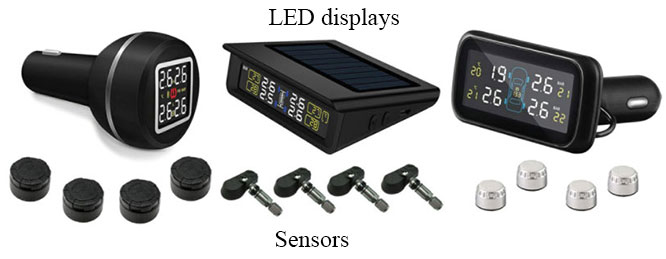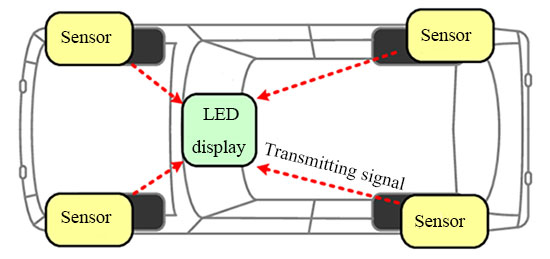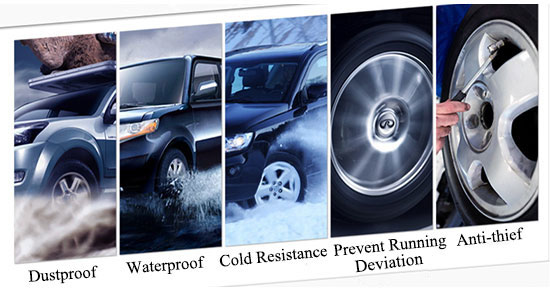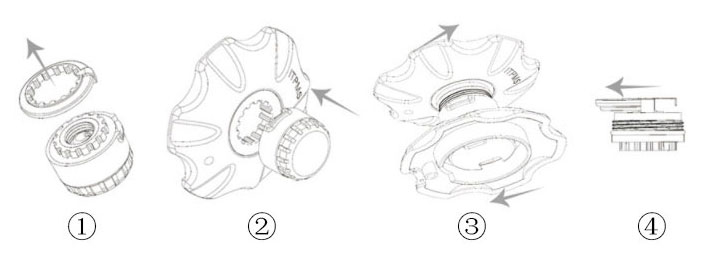TPMS
Mini TPMS with 4 Tire Sensors
Solar Power Car TPMS with 4 Tire Sensors
Car TPMS with 4 Wireless Tire Sensors
Car TPMS for Honda/Masida/Toyota/Nissan
Motorcycle TPMS with 2 Tire Sensors
RV TPMS with 6 Tire Sensors, Solar Power
Wireless Truck TPMS with 22 Tire Sensors
![]() What Is TPMS?
What Is TPMS?
The full name of TPMS is Tire Pressure Monitoring System, also called tire pressure monitor or tire pressure alarm, which is the same as the three major safety systems of automobiles, along with automobile airbags and anti-lock braking systems (ABS). Its main function is to automatically monitor the tire pressure in real-time during the vehicle driving process and give alarms for tire leaks and low/high air pressure to ensure driving safety.
The tire pressure monitoring system is generally installed on the wheel rim. The external or built-in sensors sense the air pressure in the tires, convert the air pressure signal into an electrical signal, transmit the signal to the receiver through a wireless transmitter, and display every tire pressure on the color LED display. According to the real-time tire pressure and temperature, the driver can inflate or deflate the tires in time. And even discovering tire leakage can be dealt with in time, so that the big accident can be resolved early in a small place.
TPMS is equipped with different sensor types and numbers according to different vehicle models. Generally, motorcycle TPMS has 2 sensors, car TPMS has 4 sensors, RV TPMS has 6 sensors, and large truck TPMS can be equipped with 22 sensors at most. And all the TPMS can detect tires pressure and temperature simultaneously.
At present, the United States, the European Union, Japan, South Korea and other countries and regions have all legislated to implement mandatory vehicle installation of TPMS.


Here on Tool.com, we provide a series of TPMS (Tire Pressure Monitoring System) at favorable price to meet your needs of different vehicles like motorcycle, Honda car, RV and truck, such as RV TPMS with 6 tire sensors. Each model of TPMS tire pressure monitors comes with different types of tire sensors including external sensors and built-in sensors for options. The TPMS monitor display is charged with cigarette lighter or USB power cable. Solar power car TPMS is also available here. With wireless remote sensing technology, our TPMS can help you predict air leakage, prevent tire burst, detect swelling, reduce wear, and prevent running deviation. Just move on, you will find the great advantages of our TPMS and learn its ease of installation and setup.

![]() What's the Function of TPMS?
What's the Function of TPMS?
- The wireless TPMS could monitor temperature and pressure of tires in real time, foresee the air leakage and give voice alerts in 3 seconds.
- When the tire has much high pressure, TPMS will sound the alarm to the driver to prevent tire burst so as to ensure safe driving.
- Real-time monitoring and display of data is the best helper for driving, which can help driver discover the swelling of tires and solve it timely.
- The installation of TPMS can effectively reduce tire wear or even avoid tire damage caused by running flat.
- It can prevent running deviation. If tire pressure is too high or too low, it will cause the wheel to deviate on the road. The tire pressure monitoring system can help monitor tires and display the real-time data for drivers so as to they can take actions to the tires in time.
![]() What's the Feature of TPMS?
What's the Feature of TPMS?
- TPMS LCD display monitors and displays pressure and temperature of tires in real time with high degree accuracy and updates the real-time data for the whole tires simultaneously and automatically.
- Multiple anti-interference functions of TPMS keep stable during driving.
- Smart freescale chips in sensors imported from USA provide more stable and accurate signal transmission.
- The tire pressure monitoring system can immediately warn if the tire is abnormal.
- Real-time monitoring of tire temperature can prevent tire puncture accidents for drivers on the road.
![]() What's the Feature of LED Display in TPMS?
What's the Feature of LED Display in TPMS?
After the vehicle starts, the monitor automatically starts intelligently, the display automatically adjusts the brightness according to the light perception and the sensor automatically transmits data to the display. The LED display also comes with charging protection function for safe use and prolonging service life and its working temperature is 0-80℃.
- When the LED display senses the temperature to 70℃, it will automatically stop charging.
- When the LED display senses the temperature to 80℃, it will stop working and starts self-protection.
- When the temperature drops back to the normal, the LED display will automatically start to resume the normal monitoring state.
![]() The Alarm Status of LED Display
The Alarm Status of LED Display
There are five types of alarms in TPMS on Tool.com and the alarm values can be set by user. The tire pressure monitor is equipped with five-alarm modes (high pressure, low pressure, high temperature, air leakage and sensor low battery alarm), promptly reporting the abnormal tire condition to the driver for safe driving. Drivers can set the maximum and minimum alarm values for tire pressure and temperature according to their own needs.
Let's take RV TPMS with 6 tire sensors as an example now. The high pressure alarm value is set to be 4.0 bar, the low pressure alarm value 2.0 bar, the high temperature alarm value 65℃. When the tire monitoring data exceeds the preset safety range, the corresponding value on the display flashes, the fault icon will be displayed and the alarm sound will be issued. Press any key to cancel the alarm sound, but other alarm prompt data will still be displayed until the fault is eliminated.
 |
>> High tire pressure alarm. The tire pressure is higher than the set range. |
 |
>> Low tire pressure alarm. The tire pressure is lower than the set range. |
 |
>> High tire temperature alarm. The tire temperature is higher than the set range. |
 |
>> Tire leakage alarm. |
 |
>> Low power sensor alarm. |
![]() How to Install External Tire Sensors?
How to Install External Tire Sensors?
Step 1. Unscrew the valve cap.
Step 2. Insert the dustproof cover into the valve stem.
Step 3. Screw the nut.
Step 4. Screw the sensor.
Step 5. Tighten the nut on the sensor by using the spanner.
Step 6. Check air leakage by spraying soapy water.

![]() How to Replace the Batteries of External Tire Sensors?
How to Replace the Batteries of External Tire Sensors?
Step 1. Remove the gasket.
Step 2. Put it in the opener wrench tool.
Step 3. Unscrew the shell with the opener wrench.
Step 4. Remove the old button battery and insert a new one.

![]() How to Install Internal Tire Sensors?
How to Install Internal Tire Sensors?
Step 1. Take off the tire first, pull out the original valve and clean up the residue on the wheel rim.
Step 2. Insert the internal tire pressure sensor into the valve hole of the wheel rim.
Step 3. Use hex wrench in the tool set to fix the sensor and then tighten the nut.
Step 4. Adjust the angle of the sensor to a suitable position according to the rim.
Step 5. Use hex wrench to lock and fix the sensor again.
Step 6. Install the tires and wheel rim and use the tire inflator to inflate the tire full.
Step 7. Dynamically balance all tires and match lead blocks and install all the tires back.


![]() How to Replace the Batteries of Internal Tire Sensors?
How to Replace the Batteries of Internal Tire Sensors?
You may not replace the batteries of all internal tire sensors by yourself, but you can make it when you use some Tool.com tire sensors, which are continuously updated by our professinal production teams. Here are the steps to replace the batteries of internal tire sensors.

Step 1. Remove the battery cover.
Step 2. Remove the battery-powered sheet.
Step 3. Take out the battery.
Step 4. Replace it with a new battery.








